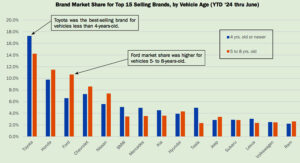Individual OEMs have unique challenges to solve as they jockey to see who can slice into Tesla’s market share lead
Grand Rapids, Mich.—As automotive manufacturers ramp up electric vehicle production to meet aggressive government targets, sales are not keeping pace with current inventory levels, causing EV days-to-move to more than double. In addition, while Tesla is firmly entrenched as the EV market share leader, no other manufacturer has emerged as a strong number two.
These findings are part of “Charging Ahead: Which EV Brands Will Dominate the Next Decade? A Comprehensive Report Covering the Past, Present, and Future of Electric Vehicles by OEM,” by Rick Wainschel, VP of Data Science and Analytics at Cloud Theory.
“The Biden administration has called for EV share to hit 67% by model year 2032, which is an Apollo-moonshot-level undertaking for the auto industry,” said Wainschel. “EV sales are rising but are not keeping pace with EV inventory growth. In early 2023, the average EV sold after 36 days on a dealer’s lot. That has more than doubled to 80 days in September 2023.”
Cloud Theory found EV inventory has nearly doubled from 3% of available new vehicle inventory in January 2023 to 6% in September 2023. In the same timeframe, EV sales have gone from 3% of vehicle market share in January to 4% in September. In addition, the number of EV models with average inventories of 1,000 or more ranged between two and six from Q3 2021 to Q3 2022. That number has jumped to 27 in Q3 2023 — reflecting the numerous new introductions over the past year.
While many OEMs have comprehensive plans to increase supply in the coming years, consumer demand is not currently on the path to keep pace.
The Associated Press-NORC Center for Public Affairs Research indicated that only 19% of adults in the U.S. said they would be extremely or very likely to buy an electric vehicle the next time they are in the market. 47% said they are not likely to do so.
The auto industry faces multiple hurdles to clear to meet the 2032 goals, including:
- Improving battery capacity to provide peace of mind and extend driving range.
- Building out infrastructure to make recharging as accessible, fast, and convenient as stopping at a gas station.
- Creating charging equipment standards (or adaptors) that are universally suitable for all makes and models.
- Overcoming consumer reluctance by touting vehicle benefits through aggressive marketing and social media.
- Overcoming entrenched business interests from groups such as oil companies and creating and subsidizing new industries and economies to replace them.
In addition to macro-level issues for the industry to overcome, individual manufacturers have unique challenges to solve as they jockey to see who can slice into Tesla’s market share lead.
“Tesla is obviously the dominant player in the market right now and is well-positioned to maintain a leadership position,” Wainschel said. “The big question is which manufacturer will emerge to challenge Tesla’s dominance. So far, the field is still pretty wide open as to who will become a front runner in this sector of the industry.”
From a share-of-sales perspective, both BMW and Mercedes-Benz have EVs accounting for more than 12% of their total sales year-to-date in 2023 (through September). However, each lags in terms of volume, with BMW selling 28,635 EVs and Mercedes-Benz selling 26,319.
Comparatively, GM and Ford fare well with 2023 volumes reaching 34,938 and 36,008 units, respectively. However, EVs currently account for only 2.2% and 3.4% of each company’s total sales.
The Hyundai Motor Group has one of the most established EV lineups among current competitors, with six vehicles with inventory levels above 1,000 in 2023. Its vehicle movement total through September of 51,640 (4.7% of total) is behind only Tesla.
“Getting to the end of this road, where the vast majority of new vehicles are EVs in just nine short years, will require technological shifts that cannot be foreseen and competitive dynamics that cannot be fully predicted,” Wainschel said. “What is clear, however, is that the automotive industry is at a profound inflection point and will not look like it currently does ten years from now. And those entities that assume a leadership role in the EV space will be the new pioneers in our ongoing journey of innovation and invention.”
Download the entire 40 page report here, which includes detailed insights into the current leading OEMs in the EV market.





Comments are closed.